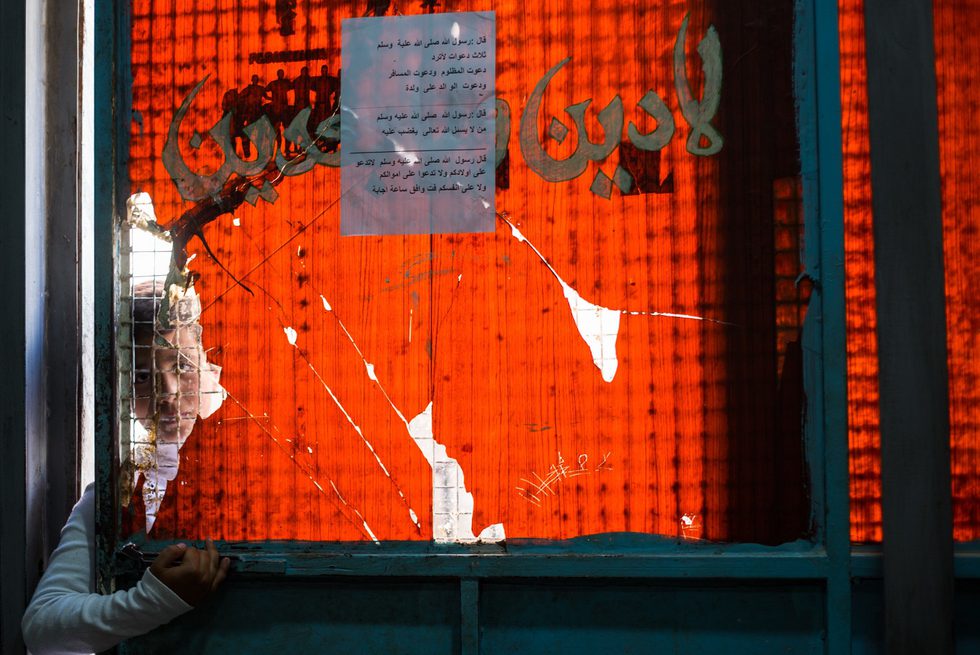
On a winding two-lane road, just a few kilometers southwest of the ancient city of Jarash, a small refugee camp punctuates the Jordanian landscape. Established in 1968 to shelter Palestinians displaced from the Gaza Strip, this is not a typical camp. There are no tents or barbed-wire fences here. Instead, there are the features of a different crisis: long-term displacement. Now fifty years old, the camp presents itself through signs of structural segregation and neglect. Smooth roads are riddled with large potholes. Mounds of trash burn on empty lots. Dilapidated buildings compete for limited space. The camp’s interior is not much different: stuck in a state of permanent temporariness, it too betrays the camp’s enduring marginality. Most of the uneven streets are still too narrow to accommodate vehicles. Largely unpaved, they’re dusty in the summer and muddy in the winter. On many homes, temporary zinco sheets still function as ceilings. Surrounded by trash and debris, children congregate on the streets using whatever they find to play (Image 6). With only one playground in the camp, they are forced to create their own landscapes of fun. This is the Gaza Camp (mukhayyam Gaza).1
Yet the camp’s rough conditions are only part of the story. Beyond the obvious material deprivations of long-term encampment (Agier 2002; Knudsen 2016), there is also a vibrant, more purposeful sense of camp sociality. Visible in the routine activities of everyday life, there is a dimension of the Gaza Camp that results from Palestinians’ efforts to endure the predicament of displacement and statelessness while making the camp their own space of refuge. It is present in the central market where Palestinians gather daily to buy and sell an array of goods. Here, anything from local herbs to imported birds can be found (Images 4–5). Near the market, it can be perceived near one of the camp bakeries, where the smell of fresh bread floods the street (Images 7–9). The bakery’s owner, an affable and diligent man, places large stacks of warm pita into plastic bags for his customers to take home (Image 10). On the east side of the camp, not too far from its border, this sensibility can also be found behind a large steel door, where young men gather every day to talk, smoke, and play video games on old Sony Playstations (Images 14–17). These are just some of the scenes that constitute the Gaza Camp we came to know over the course of our fieldwork. This is the camp we aim to reveal in this photo essay.
A collaborative effort between an anthropologist and photojournalist, this photo essay engages ordinary life among stateless Palestinians in the context of long-term displacement. It takes the visual theme of repetition as an occasion for exploring the meaning of the everyday for a particular community of refugees. Specifically, our essay presents an opportunity for rethinking the significance of the ordinary in ordinary life. Most theorists of the everyday recognize the centrality of repetition and routine in its production. In Henri Lefebvre’s (1991) work, for example, everyday life is constituted through repeated gestures of labor and leisure, mechanical movements both human and machine. Agnes Heller (1984) similarly locates repetition at the center or everyday life underscoring its role in the reproduction of both the self and the social. Yet scholarly attention to the mundane has often downplayed the significance of habit and repetition while privileging moments of creativity and rupture (see Das 2012). Whether in the form of moments, tactics, the carnival, or ordinary encroachments (Bakhtin 1984; de Certeau 1984; Bayat 2010), the analysis of the everyday has focused on the practice of resistance. Such approaches have positioned ordinary life as either the site of subordination or subversion, and they have made agency coterminous with acts that either refuse repetition or deploy it against the forces of domination (Scott 1990).
Our focus on the everyday lives of stateless Palestinians offers a different perspective. In this essay, we invite the viewer to see ordinary life and the repetitions that make it possible as extraordinary affairs. To suggest that the routines of everyday life are extraordinary requires a particular way of seeing those practices that goes beyond the frame of each image. It necessitates a viewing that combines the visible acts of repetition with the unseen conditions of unordinary life against which these acts labor. Such an approach begins with an appreciation of the unique circumstances from which the everyday is made. It is, as Heller (1984, 54) has argued, to start with the understanding that people are born into a given world and it is the conditions imposed by this given world that they must appropriate and make their own if they are to survive. For these stateless Palestinians, the given world involves adjustment to various limits that make the most mundane efforts a considerable struggle. Palestinians displaced from Gaza cannot own property, work in the public sector, or join or form unions. They cannot vote, access government health care, or attend national schools. Beyond the restrictions of statelessness, these Palestinians must also contend with the diminishing support of international aid and the increasing insecurities of the Jordanian labor market. Suffice it to say that these constraints and others constitute some of the given for stateless Palestinians. They provide a set of grinding conditions that can make the stability of everyday life a significant effort and accomplishment.
The unseen exclusions of statelessness in each image are not, however, the entire picture. Within the visible acts of repetition in this essay there is also something more, another unseen that signals a sense of achievement in the ordinary for Palestinians. It is what affords ordinary life an extraordinary element and constitutes the camp as a refuge for a stateless people. In the images of a gaming shop, for example, we find an alternative to the life of a male laborer whose everyday routine once involved irregular work between cities, often for little pay, and at the expense of his time with family. We also see the social opportunities this space creates for young male customers seeking refuge from the boredom of their marginal status. For many involved, the significance of this shop transcends its naked appearance. At a soap factory on the north side of the camp, the repeated act of preparing, packaging, and shipping locally produced soaps is also an important achievement (Images 2–3). Its daily performance allows a Palestinian mother to earn her own income without disrupting her familial obligations in the camp. Although a modest salary, the small enterprise provides her with the ability to pay for food, her children’s schooling, or husband’s medical treatment. The repetition of labor thus becomes entangled with relations of care and the enactment of motherhood in a country with few opportunities for stateless women. And, in the intimacy of the home, the daily preparation and consumption of food and drink are inseparable from the combined efforts of a laboring family who, together, make possible the fullness of a meal (Images 18–20).
Focused on the conduct of everyday life, the photographs in this essay also work within its logic. Many of the images we provide thus conform to the routinization of practices that turn repetition into particular forms of social reproduction. The ubiquity of men throughout the camp, for example, facilitated their representation as agents in the making of the everyday. It also, however, reflected the almost unlimited privilege men enjoy within the regulatory norms of gender. Men were seen because they could be seen. Their presence before the camera mirrored their normative position in the spatial rules of the camp. Young women, on the other hand, do not experience the same access to public space. Their mobility is constrained by distinct norms of gender that make their visibility in the camp less accessible than that of men. The logic of these norms led most young women to refuse the gaze of our camera. For them, photography represented a form of public visibility that they could not control and thus had to avoid. Complying with the desires of young women in the camp, our images do not include their presence. In this way, our essay respects the demands of our interlocutors but also reproduces the norms of everyday life that govern women’s access to space and thus visibility. More specifically, the absence of young women in our photographs reproduces the very norms that make women’s invisibility in particular spaces seem ordinary.
The stories behind these images are not unique. They are just some of the ways stateless Palestinians engage in the struggle to make life repeatable, ordinary. For these Palestinians, the repetition of the everyday is therefore an event in itself. It is an agential happening born of the necessities of survival (see Allen 2008) that not only affords individuals and their families the opportunity of an ordinary life but also produces configurations of the social that extend to other camp residents. The visible acts of repetition in each image can thus be seen as a critical point in a constellation of acts that, together, constitute the Gaza Camp as a site of refuge. Repeated daily, they bring work closer to home, keep families together, and enable particular forms of sociality. And yet the eventfulness of the ordinary for these stateless Palestinians is always incomplete. Within each site, behind each activity, there is an underlying sense of temporality constituted by the event of their displacement and the colonization of Palestine. Conducted from the position of refugees forcibly displaced from their homes and denied the right to return by the Israeli state, an ordinary existence in the Gaza Camp is only ever a partial achievement. More an adaptation than a solution, the ordinary acts represented in this essay must be understood as collective efforts to survive—not overcome—the precarious conditions of exile. They represent the struggle against the chronic, cruddy, yet noncatastrophic (see Povinelli 2011) violence of expulsion and the logic of the settler nation-state.
The labors of ordinary life in these images thus point to a process, not an end. Unfinished, they reflect an intensity of living and becoming that, as Elizabeth Povinelli has emphasized, requires endurance and striving (see also Biehl and Locke 2017). Indeed, the repeated practices of daily life visible in these images can be tiring. Their demands can exhaust the body and bore the mind. But sometimes exhaustion and boredom are desirable. They can provide an alternative to another life marked by far worse conditions and outcomes. Thus, in this essay, we highlight the active production of a more and less ordinary life. Through these images, we aim to convey the complexity of repetition in the everyday: as achievement and limit, both stable and fragile. Made possible through endurance and exhaustion, against uncertainty and disadvantage, and with satisfaction and disappointment, we invite the viewer to see how these Palestinians experiment with possibilities in order to live an extraordinarily mundane life.
Note
1. The camp’s official name is Jarash. It is one of thirteen United Nations Relief and Works Agency camps for Palestinian refugees in Jordan.

Download “Repetition and Extraordinary Living in the Gaza Camp” by Michael Vicente Pérez and Elena Boffetta as a pdf booklet.
Photos
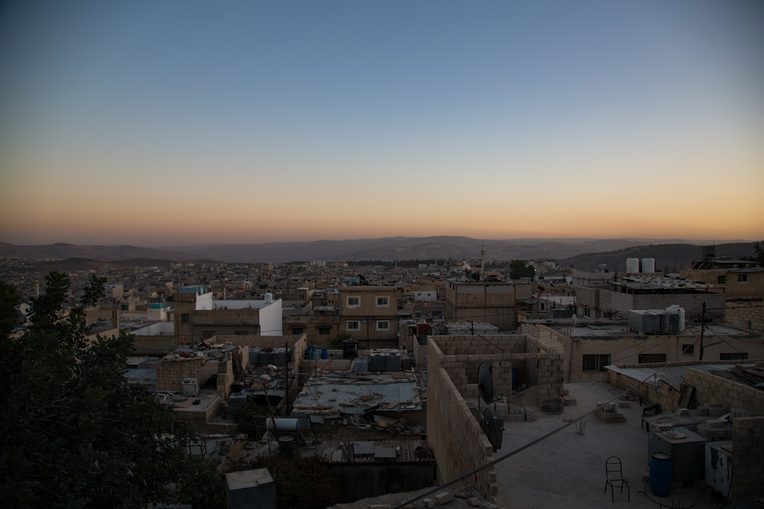
Established in 1968, the Gaza Camp is home to approximately thirty thousand Palestinian refugees. Unable to return to Palestine and denied Jordanian citizenship, camp residents live in a condition of permanent temporariness, visible in this image through the combination of zinco roofs and concrete walls.

A woman stacks soap made from local olives for a social enterprise called Sitti Soap. Linking Palestinian methods of production with an international market, the company offers critical employment opportunities for women and men in the camp. For the Palestinians who work here, soap production is much more than work. It is the routine enactment of an ordinary life marked by skilled labor and a stable income.

Hand-crafted soap is boxed for international distribution.

A woman sells birds at the central market. Every Friday, camp residents sell pigeons, turkeys, and other birds for local consumption.

Fresh herbs for sale in the camp market. Many Gaza refugees work in seasonal agricultural economies that bring regional produce to the camp.
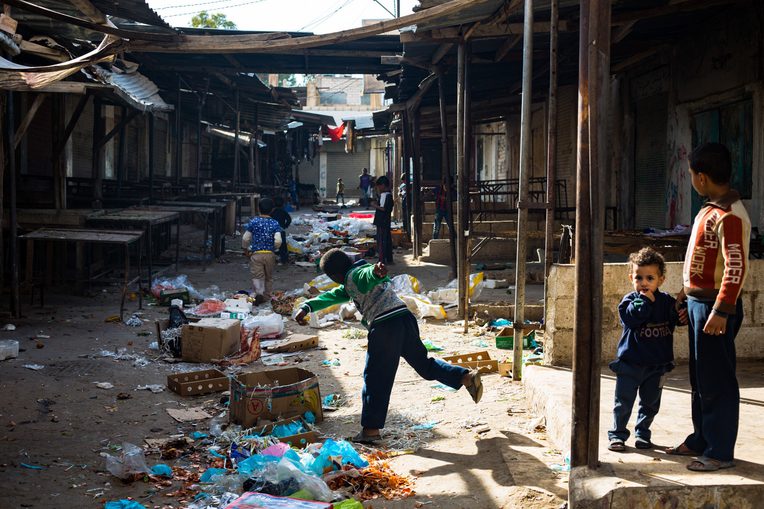
Children play with whatever scraps they find after the market closes.

A small bakery produces bread for camp residents.

A staple of Palestinian meals, bread is produced without interruption.

Fresh pita on its way to the stacks.

Daily demand means daily work for a baker.

A camp resident selects a chicken for a family meal.

The repeated rhythms of preparation: slaughter, defeather, and butcher.

A butcher works every day to ensure an income.
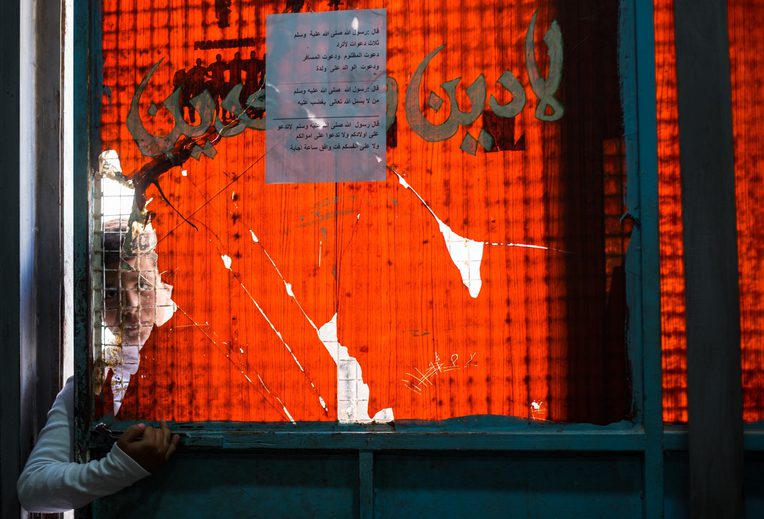
A young Palestinian joins his friends at the Sony Playstation shop.

Waiting for his chance to play, a boy is transfixed by a game of Tekken.
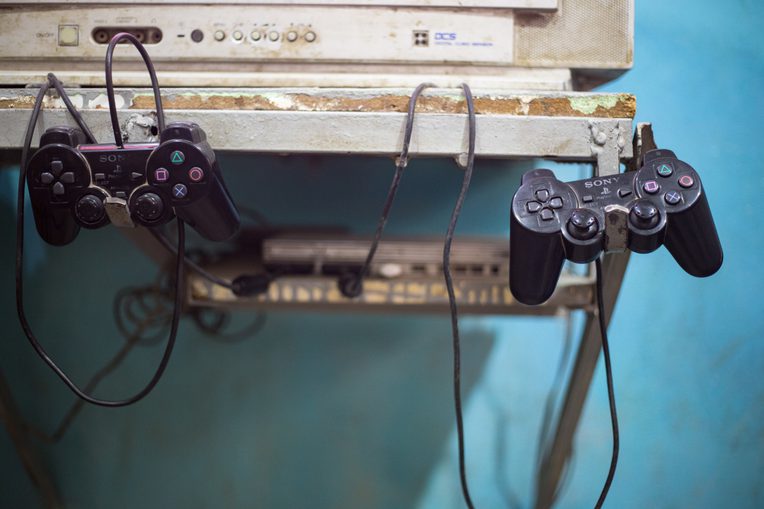
An old Playstation can offer a critical break from the boredom of camp life.

Known as the “Sony,” this small shop provides a site for boys and young men to play games, smoke, talk, and pass the time. Exclusive to boys and men, the space reflects the logic of gender separation within the camp and reinforces homosocial bonds between male youth.
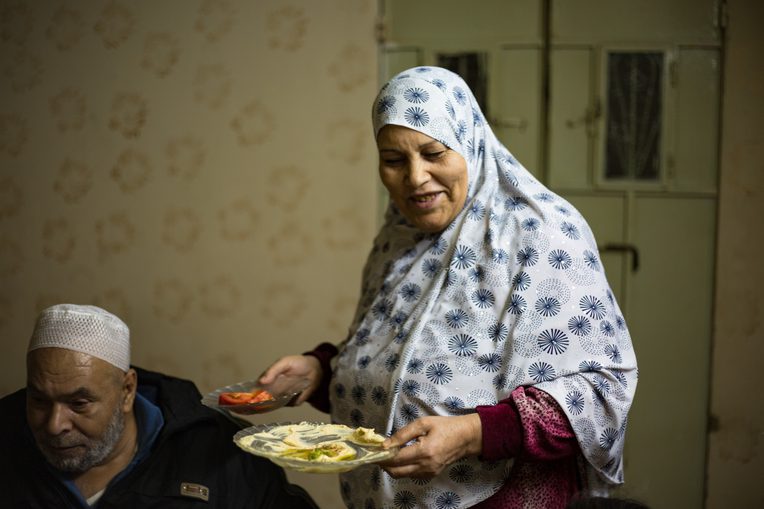
A grandmother clears the table after a family meal.

Children watch as their grandfather prepares for his daily prayers.
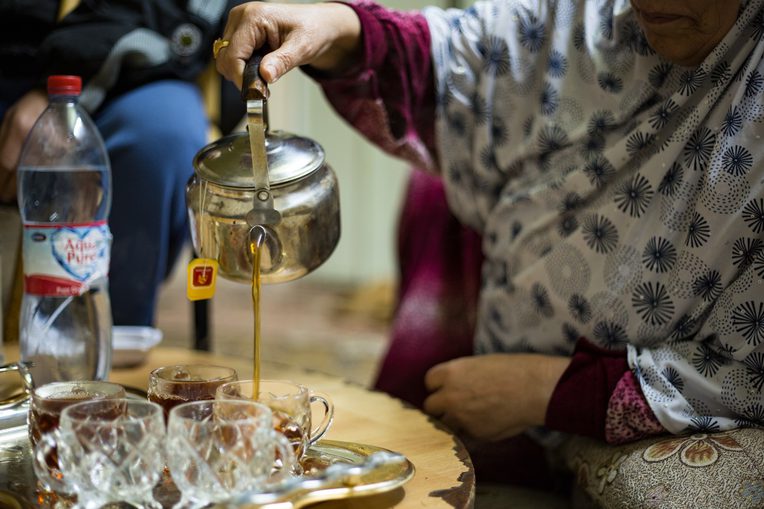
Served dark and heavy with sugar, tea is central to daily life in the camp.
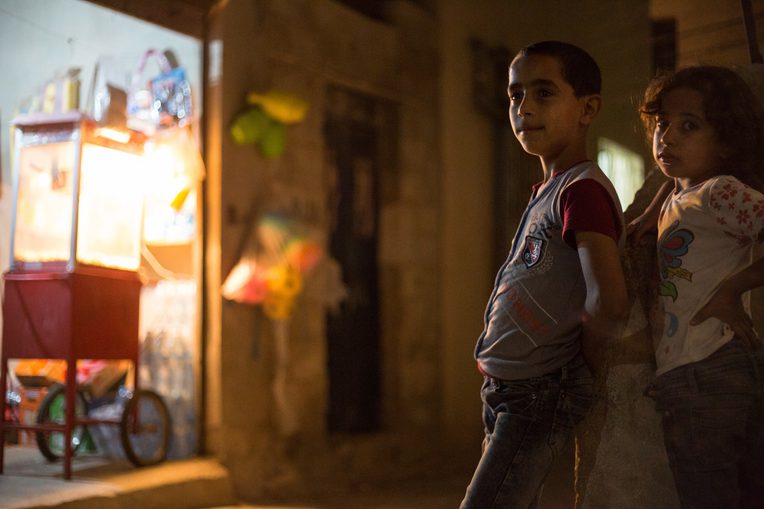
Children ponder our presence while a convenience store sells popcorn on a warm autumn night.
References
Agier, Michel. 2002. “Between War and City: Toward an Urban Anthropology of Refugee Camps.” Ethnography 3, no. 3: 317–41.
Allen, Lori. 2008. “Getting by the Occupation: How Violence Became Normal during the Second Palestinian Intifada.” Cultural Anthropology 23, no. 3: 453–87.
Bakhtin, Mikhail. 1984. Rabelais and His World. Translated by Hélène Iswolsky. Bloomington: Indiana University Press. Originally published in 1965.
Bayat, Asef. 2010. Life as Politics: How Ordinary People Change the Middle East. Stanford, Calif.: Stanford University Press.
Biehl, João, and Peter Locke. 2017. “Foreword: Unfinished.” In Unfinished: The Anthropology of Becoming, edited by João Biehl and Peter Locke, ix–xi. Durham, N.C.: Duke University Press.
Das, Veena. 2012. “Ordinary Ethics.” In A Companion to Moral Anthropology, edited by Didier Fassin, 133–49. Malden, Mass.: Wiley-Blackwell.
de Certeau, Michel. 1984. The Practice of Everyday Life. Translated by Steven Rendall. Berkeley: University of California Press. Originally published in 1980.
Heller, Agnes. 1984. Everyday Life. New York: Routledge. Originally published in 1970.
Knudsen, Are J. 2016. “Camp, Ghetto, Zinco, Slum: Lebanon’s Transitional Zones of Emplacement.” Humanity 7, no. 3: 443–57.
Lefebvre, Henri. 1991. Critique of Everyday Life, Volume 1. New York: Verso. Originally published in 1947.
Povinelli, Elizabeth A. 2011. Economies of Abandonment: Social Belonging and Endurance in Late Liberalism. Durham, N.C.: Duke University Press.
Scott, James C. 1990. Domination and the Arts of Resistance: Hidden Transcripts. New Haven, Conn.: Yale University Press.